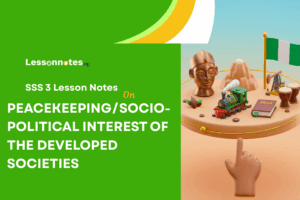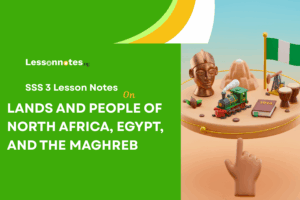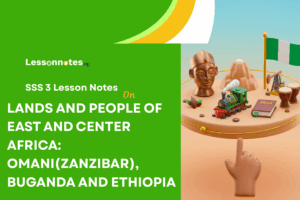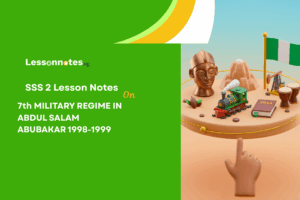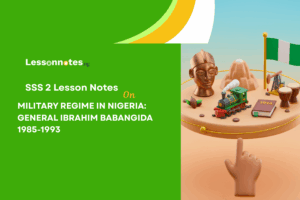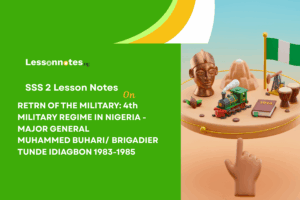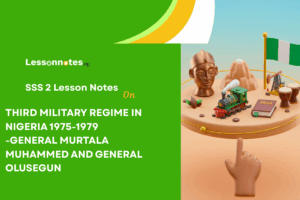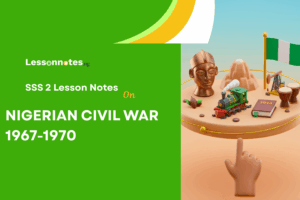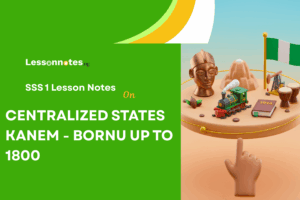Land And People In Southern Africa: Bantu SS3 Nigerian History Lesson Note
Download Lesson NoteTopic: Land And People In Southern Africa: Bantu
Southern Africa is a region with diverse landscapes and people. The Bantu peoples are a large group who have lived in this region for many centuries. They have rich histories, cultures, and traditions. This lesson will explore the lands of Southern Africa, the Bantu peoples who live there, their ways of life, and how they have shaped the region over time.
Geography of Southern Africa
Countries in Southern Africa
Southern Africa generally includes these countries:
- South Africa
- Namibia
- Botswana
- Zimbabwe
- Zambia
- Malawi
- Mozambique
- Angola
- Lesotho
- Eswatini (formerly Swaziland)
Major Geographical Features
Plateaus and Mountains
- High Veld: A large plateau covering much of South Africa, Zimbabwe, and parts of Botswana
- Great Escarpment: Steep slopes that separate the high inland plateau from the lower coastal areas
- Drakensberg Mountains: Highest mountain range in Southern Africa
- Cape Fold Mountains: Mountain ranges in the southwestern part of South Africa
Rivers and Lakes
- Zambezi River: Fourth-longest river in Africa, forms Victoria Falls
- Limpopo River: Forms the border between South Africa and its northern neighbors
- Orange River: Flows across South Africa to the Atlantic Ocean
- Lake Malawi: Third-largest lake in Africa
Deserts and Dry Lands
- Kalahari Desert: Large semi-desert region covering parts of Botswana, Namibia, and South Africa
- Namib Desert: Coastal desert in Namibia, one of the oldest deserts in the world
- Karoo: Semi-desert region in South Africa
Coastal Areas
- Long coastline along the Atlantic and Indian Oceans
- Important harbors and ports
- Different coastal environments from wet to dry
Climate
Southern Africa has several climate zones:
- Mediterranean Climate: Found in the southwest Cape area with wet winters and dry summers
- Desert and Semi-Desert Climate: Very dry with extreme temperatures in Namib and Kalahari
- Subtropical Climate: Warm and humid along the eastern coast
- Temperate Climate: On the high plateaus with warm summers and cool winters
- Tropical Climate: In the northern parts with distinct wet and dry seasons
Who Are the Bantu Peoples?
Origins and Migration
- The term “Bantu” refers to a large group of related peoples who speak Bantu languages
- Originally from West-Central Africa (around modern Cameroon and Nigeria)
- Began migrating southward around 2,000 years ago
- Gradually spread throughout Central, Eastern, and Southern Africa
- Brought knowledge of iron-working, farming, and cattle-keeping
- Settled in different areas according to environmental conditions
Major Bantu Groups in Southern Africa
There are many Bantu groups in Southern Africa. Some of the major ones include:
Nguni Peoples
- Zulu: Largest ethnic group in South Africa, historically formed a powerful kingdom
- Xhosa: Second-largest group in South Africa, known for clicks in their language
- Swazi: Main ethnic group in Eswatini, also live in parts of South Africa
- Ndebele: Found in Zimbabwe and South Africa
Sotho-Tswana Peoples
- Sotho: Including Southern Sotho (in Lesotho and South Africa), Northern Sotho, and Tswana (in Botswana and South Africa)
- Pedi: A Northern Sotho group in South Africa
Shona Peoples
- Largest ethnic group in Zimbabwe
- Include subgroups like Karanga, Zezuru, and Korekore
Other Important Groups
- Venda: Live in northern South Africa
- Tsonga/Shangaan: Found in South Africa, Zimbabwe, and Mozambique
- Ovambo: Largest ethnic group in Namibia
- Herero: Another important group in Namibia
- Tonga: Live around the Zambezi Valley in Zambia and Zimbabwe
- Lozi: In western Zambia
- Chewa: Major group in Malawi
Traditional Bantu Ways of Life
Settlement Patterns
- Villages of varying sizes depending on the environment
- Houses traditionally built in circular shape
- Settlements often organized around a central cattle kraal (enclosure)
- In some areas, settlements built on hilltops for defense
- Location often determined by access to water, fertile land, and grazing
Traditional Housing
- Round Huts: Made with a wooden frame, clay walls, and thatched roofs
- Beehive Huts: Used by some groups like the Zulu, made entirely of plant materials
- Homesteads: Collection of several houses for an extended family
- Decorations: Many groups decorated their homes with geometric patterns
Economic Activities
Agriculture
- Growing crops was a main activity for most Bantu peoples
- Main Crops: Sorghum, millet, and later maize (corn)
- Other Crops: Beans, pumpkins, sweet potatoes, groundnuts
- Farming Methods: Shifting cultivation in some areas, permanent fields in others
- Tools: Wooden and iron hoes for cultivation
- Division of Labor: Women often did most farming while men cleared land
Cattle Keeping
- Cattle were extremely important in most Bantu cultures
- Represented wealth and status
- Used for milk, meat (on special occasions), hides, and manure
- Important in social transactions like marriage payments (lobola/bride wealth)
- Cattle raiding was common among some groups
Hunting and Gathering
- Supplemented farming and herding
- Men hunted with spears, bows and arrows, and traps
- Women gathered wild fruits, nuts, roots, and vegetables
- Important during times of drought or crop failure
Crafts and Industries
- Ironworking: Smiths made tools, weapons, and ornaments
- Pottery: Clay pots and vessels for cooking and storage
- Basketry: Various types of baskets for different purposes
- Woodcarving: Tools, weapons, household items, and sometimes sculptures
- Beadwork: Especially important among groups like the Zulu and Ndebele
Trade
- Between different Bantu groups
- With non-Bantu neighbors
- Later with Arab, Portuguese, and other European traders
- Items traded included salt, iron, copper, beads, cloth, and eventually European goods
Social Organization
Family Structure
- Extended family was the basic social unit
- Patrilineal system (tracing descent through the father’s line) in most groups
- Polygamy (multiple wives) common, especially for wealthy men
- Age-grade systems in some societies, where people of similar age had specific roles
Political Systems
Bantu groups had different types of political organization:
- Centralized Kingdoms: Like the Zulu, Swazi, and Lozi, with kings having significant power
- Chiefdoms: Smaller political units led by chiefs
- Decentralized Systems: Where authority rested with family heads, elders, or councils
Role of Chiefs and Kings
- Leading in warfare
- Administering justice
- Performing religious ceremonies
- Distributing land
- Mediating disputes
- Collecting tribute
Role of Elders
- Providing wisdom and guidance
- Teaching traditions to younger generations
- Making important community decisions
- Performing rituals and ceremonies
Religious Beliefs and Practices
Traditional Beliefs
- Belief in a supreme creator god
- Veneration of ancestors who were believed to influence daily life
- Spirits associated with natural features like rivers, mountains, and forests
- Rituals to ensure good harvests, rainfall, health, and protection
Religious Specialists
- Diviners: Could communicate with ancestors and spirits to determine causes of misfortune
- Herbalists: Used plant medicines to treat illnesses
- Rain-makers: Performed rituals to bring rain during droughts
- Spirit Mediums: Could be possessed by ancestor spirits to give guidance
Important Ceremonies
- Initiation ceremonies marking transition to adulthood
- Harvest festivals
- Rain-making ceremonies
- Ancestor veneration rituals
- Purification ceremonies
Art and Cultural Expression
Music and Dance
- Important part of ceremonial and social life
- Various drums, string, and wind instruments
- Complex rhythms and vocal harmonies
- Dance styles particular to different cultural groups
Oral Traditions
- Histories, stories, and knowledge passed down orally
- Praise poetry (izibongo) celebrating leaders and heroes
- Proverbs and riddles teaching moral lessons
- Professional storytellers in some societies
Visual Arts
- Beadwork with distinctive patterns and color combinations
- Wall paintings and house decorations
- Carved wooden items including headrests and figurines
- Metalwork including ornaments and ceremonial objects
Historical Developments
Formation of States and Kingdoms
Several important kingdoms and states emerged among Bantu peoples:
- Zulu Kingdom: Founded by Shaka in the early 19th century, became powerful through military innovations
- Ndebele Kingdom: Founded by Mzilikazi, who left Zulu territory and established a new state
- Swazi Kingdom: Developed under leaders like Sobhuza I and Mswati II
- Rozwi Empire: Dominated the Zimbabwe plateau before European colonization
- Lozi Kingdom: Important state in western Zambia with complex flood adaptation systems
- Mutapa State: Controlled trade between the interior and the Indian Ocean coast
The Mfecane/Difaqane Period
- Time of massive upheaval in Southern Africa (1810s-1830s)
- Triggered by Zulu expansion under Shaka
- Led to widespread migration, warfare, and political reorganization
- Created new states and changed ethnic boundaries
- Depopulated some areas which were later claimed by European settlers
Encounter with Europeans
European presence gradually increased in Southern Africa:
- Portuguese established coastal trading posts from the 1500s
- Dutch settled at the Cape from 1652
- British took over the Cape Colony in 1806
- European missionaries, traders, and explorers ventured inland
- Discovery of diamonds (1867) and gold (1886) in South Africa intensified European interest
Colonization
By the late 19th century, most of Southern Africa came under European control:
- British colonies and protectorates
- German colony in Namibia
- Portuguese colonies in Angola and Mozambique
- Boer Republics (later incorporated into British territory)
Resistance to Colonization
Bantu peoples resisted European expansion in various ways:
- Military Resistance: Wars against colonial forces, including:
- Xhosa-British Frontier Wars
- Anglo-Zulu War of 1879
- Ndebele and Shona risings (First Chimurenga) in Zimbabwe
- Herero and Nama uprisings in Namibia
- Political Negotiation: Some leaders tried to maintain independence through treaties and diplomacy
- Religious Movements: Including prophetic and millenarian movements promising liberation
- Labor Migration: Strategic movement to avoid certain forms of colonial control
Apartheid and Independence
- South Africa implemented formal apartheid policy from 1948
- Bantu homelands (“Bantustans”) created as part of racial segregation
- Liberation movements fought for independence and majority rule
- Most countries gained independence between 1960s-1980s
- South Africa ended apartheid in 1994 with first democratic elections
Bantu Peoples Today
Contemporary Demographics
- Bantu peoples form the majority population in most Southern African countries
- Urban migration has changed settlement patterns
- Many people combine traditional and modern lifestyles
Languages
- Bantu languages are official or national languages in most countries
- Examples include:
- Swahili (Tanzania)
- Zulu, Xhosa, Sotho, Tswana (South Africa)
- Shona, Ndebele (Zimbabwe)
- Chichewa (Malawi)
- Setswana (Botswana)
- Many others
Cultural Revival
- Renewed interest in traditional customs and practices
- Cultural festivals celebrating Bantu heritage
- Recognition of traditional leadership in some countries
- Incorporation of traditional elements in modern governance
Challenges
- Balancing traditional values with modernization
- Economic development and inequality
- Environmental issues including drought and climate change
- Land ownership and distribution
- Urbanization and changing social structures
Conclusion
The Bantu peoples of Southern Africa have a rich and complex history. They adapted to diverse environments, built sophisticated societies, and developed valuable cultural traditions. Though colonization brought many challenges, Bantu cultures and languages continue to thrive. Today, the descendants of these peoples are the majority population in Southern African countries, where they blend traditional practices with modern ways of life.
Evaluation
- Describe the major geographical features of Southern Africa.
- Explain who the Bantu peoples are and how they came to Southern Africa.
- Identify three major Bantu groups in Southern Africa and where they live.
- Discuss the traditional economic activities of Bantu peoples.
- Explain the importance of cattle in traditional Bantu societies.
Classwork
Answer the following questions:
- Name five countries in Southern Africa.
- Describe the traditional housing of Bantu peoples.
- What crops did Bantu farmers traditionally grow?
- Explain the role of ancestors in traditional Bantu beliefs.
- Name two important Bantu kingdoms that existed before European colonization.


